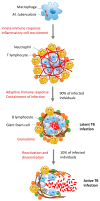Tuberculosis-Associated MicroRNAs: From Pathogenesis to Disease Biomarkers
- PMID: 32987746
- PMCID: PMC7598604
- DOI: 10.3390/cells9102160
Tuberculosis-Associated MicroRNAs: From Pathogenesis to Disease Biomarkers
Abstract
Tuberculosis (TB) caused by Mycobacterium tuberculosis is one of the most lethal infectious diseases with estimates of approximately 1.4 million human deaths in 2018. M. tuberculosis has a well-established ability to circumvent the host immune system to ensure its intracellular survival and persistence in the host. Mechanisms include subversion of expression of key microRNAs (miRNAs) involved in the regulation of host innate and adaptive immune response against M. tuberculosis. Several studies have reported differential expression of miRNAs during active TB and latent tuberculosis infection (LTBI), suggesting their potential use as biomarkers of disease progression and response to anti-TB therapy. This review focused on the miRNAs involved in TB pathogenesis and on the mechanism through which miRNAs induced during TB modulate cell antimicrobial responses. An attentive study of the recent literature identifies a group of miRNAs, which are differentially expressed in active TB vs. LTBI or vs. treated TB and can be proposed as candidate biomarkers.
Keywords: apoptosis; autophagy; biomarker; diagnosis; disease progression; innate immunity; latent infection; microRNA; pathogenesis; response to therapy; tuberculosis.
Conflict of interest statement
The authors declare no conflict of interest. The funders had no role in the design of the study; in the collection, analyses, or interpretation of data; in the writing of the manuscript, or in the decision to publish the results.
Figures



References
-
- WHO . Global Tuberculosis Report 2019. World Health Organization; Geneva, Switzerland: 2019. Licence: CC BY-NC-SA 3.0 IGO.
-
- Simmons J.D., Stein C.M., Seshadri C., Campo M., Alter G., Fortune S., Schurr E., Wallis R.S., Churchyard G., Mayanja-Kizza H., et al. Immunological mechanisms of human resistance to persistent Mycobacterium tuberculosis infection. Nat. Immun. 1996;64:683–690. doi: 10.1038/s41577-018-0025-3. - DOI - PMC - PubMed
Publication types
MeSH terms
Substances
LinkOut - more resources
Full Text Sources
Medical

